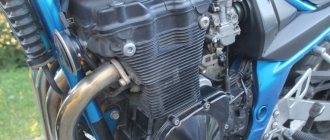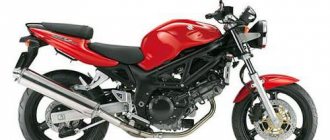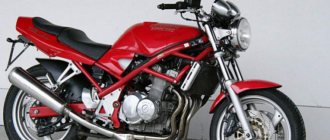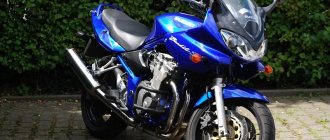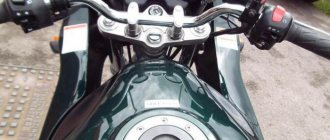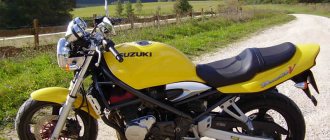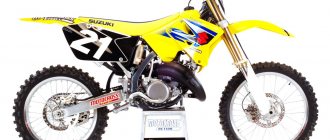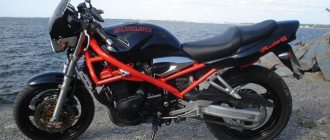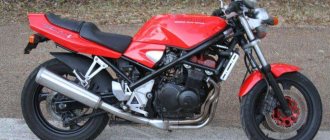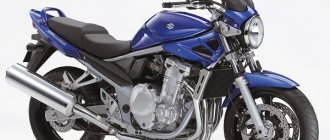GSF 750 Bandit
— a model of a
Suzuki
.
The Suzuki GSF 750 Bandit naked model appeared in 1996 and was produced until 1999. The motorcycle was aimed at the Japanese market and was not officially exported to other countries. The model was based on the air-oil engine from the sports model Suzuki GSX-R750 (1989), the frame and chassis from the Suzuki GSF 600 Bandit, and the subframe, dashboard and exhaust from the Suzuki GSF 1200 Bandit. The 6-speed gearbox is similar to the gearbox on the Suzuki GSF 600 Bandit.
An interesting point is also the fact that the Suzuki GSF750 model was not labeled “Bandit”, although most fans of the series attribute it to this class, calling it Suzuki GSF750 Bandit.
As mentioned above, the motorcycle was based on the engine from the sports version of the Suzuki GSX-R750 model of 1989, which was significantly retuned and derated. As a result, the engine began to produce 77 hp. power and 64 Nm of torque. The engine has smooth traction at low and medium speeds, and shows maximum performance at 7000-9000 rpm.
The features of the Suzuki GSF750 Bandit include a classic steel tubular frame, a 6-speed gearbox, simple suspension in the form of a conventional telescopic fork at the front and a monoshock absorber at the rear, a 19-liter fuel tank and a 224 kg curb weight.
The Suzuki GSF 750 model existed on the market until 1999, after which it disappeared from sales. The model was replaced in 1998 by the “classic” Suzuki GSX750 (Inazuma), which was practically not in demand in Japan, so most of them were sold on foreign markets.
Driving performance,
The maximum speed indicated in the documentation is 180 km/h.
The speedometer, designed in the form of a classic dial indicator, is also marked up to 180 km/h, as is the entire dashboard.
But the developers honestly stated that the model has a limiter. Users noted that if you unscrew it, the arrow will fall. According to GPS measurements, on a free road it is easy and relaxed to reach 250 km/h .
Acceleration from zero to 100 km/h according to specifications is 4.9 seconds . Users noted the same numbers: “ about 5 seconds .”
Fuel consumption
The situation with consumption is more interesting. Since the bike was initially planned only for domestic markets, consumption was indicated in the Japanese manner. Quote:
“At a constant speed of 60 km/h and 2 riders (Japanese build), consumption is 2.86 liters per 100 km. paths."
Russian users noted that with a mixed cycle one should prepare for 7 liters per 100 km . If you never go on the highway, then 8–9 liters .
Modifications and competitors
No other models based on this motorcycle were developed. Perhaps the culprit is the too short life on the assembly line.
Or maybe users are interested in the “Bandit 600”, which, according to factory information, is still produced to this day (with appropriate innovations and changes).
But the bike was not left without competitors. Of the representatives of the big Japanese four, Honda and Kawasaki offered their models. Yamaxa at that time was promoting its touring enduro - Super tenere 750 and the new Tenere 660 and did not want to break away for a one-day butterfly.
CB 750
The first competitor is the Honda CB 750, a classic road bike.
Honda introduced the CB 750 model. Aka Honda Seven Fifty , Honda Nighthawk .
The bike had:
- hydraulic compensators in the valve system;
- 5-speed gearbox;
- 2-spring shock absorber on the rear suspension;
- 1- piston calipers for the rear brake (Brembo was not offered);
- tank 20 l ;
- curb weight is less and dry weight is more.
It was produced from 1991 to 2008 with a minor break in 2003.
Kawasaki ZR-7
The design of this model has something of both classic and naked, and in technical terms, something of sport.
Kawasaki offered the ZR-7 model. She had:
- 2 valves per cylinder;
- digital ignition;
- the ability to adjust the suspension (Suzuki only had this in tuned models; the stock version did not have this).
The ZR-7 entered the market in 1999 . He finished his journey in 2005 . Unlike Suzuki, it was immediately positioned both for export and for domestic markets.
Yamaha XJ 600S Diversion
The model did not have outstanding technical characteristics, but was positioned as a simple motorcycle, the price of which was on par with some “four hundred”.
With a slight stretch, one can imagine among the competitors the Yamaha XJ 600 S Diversion, which was considered a competitor to the described Kawasaki and the Bandit 600, which formed the basis of the GSF 750.
Yamaha could boast:
- 6-speed gearbox;
- suspension adjustment;
- 2 valves per cylinder.
A tank of 17 liters , a consumption of 6 liters and a curb weight of 210 kg completed the picture.
Release within 10 years. 1992–2002 .
Years of sales
The Suzuki GSF 750 model appeared in 1996 and was produced until 1999.
The motorcycle was produced until 1998 and sold until the summer of 1999 . There were no official deliveries to other countries, but thanks to “gray” sales it became famous both in Russia and around the world.
In 1998, the concern launched the Suzuki GSX750 Inazuma . It becomes the official successor to the model in European markets. For Japan they offer the younger sister of the Suzuki GSX400 Inazuma.
Flaws
Many owners would like to see a more comfortable seat - a little softer, with a ledge in front and back.
Among the disadvantages, users noted:
- Motor . Incorrect retuning added thrust at rpm below 2500 . Further torsion causes a drawdown in thrust, which resumes only after the 4000 , when the capabilities of the jixer come into play.
- Vibrations . This drawback is noted by some people. This phenomenon is not typical for 4 cylinders, but in the interval between the above speeds it is possible.
- Uncomfortable landing . Even though the motorcycle is a street motorcycle, due to the peculiarities of its geometry, the biker is forced to sit at a semi-tilt, in a sporty manner .
- Lack of wind protection . Perhaps when creating a naked bike with a silencer, the Japanese did not think about protection. But the jammer can be removed!
and dignity
There are more advantages:
- Heavy weight, high center of gravity . For some this may seem like a minus, but during maneuvers or crosswinds it is only a plus. It is difficult to knock such a bike off the trajectory. In addition, with such a weight, wobbling is excluded (motorcyclists know what we are talking about).
- Maneuverability. Despite the weight of the behemoth, the motorcycle obediently follows the steering wheel.
The handlebars on the motorcycle are high and comfortable. The mirrors, although not large, are quite informative.
- Controllability . Low ground clearance and high center of gravity combine to provide ideal weight distribution - a prerequisite for safe driving.
- Brakes . The absence of additional systems to help stop is noted by many. But only the owners know that they are not needed on this bike. The brakes grab instantly, especially the rear. A small stroke (compared to the front one) and good calipers sometimes allow you to stop only with the pedal.
- Space for trunk and therefore the ability to install case - carry all sorts of rubbish.
The photo shows an option for installing a trunk.
- Accessories . Since the motorcycle is a hybrid, it can use two repair kits at once. Bandit 600 and bandit 1200.
Dimensions and weight
- The dry weight of the motorcycle is 200 kg .
- Equipped, taking into account a full tank and all liquids - 224 kg .
In size - an ordinary road worker:
- length - 2,090 mm;
- width - 770 mm;
- height - 1,095 mm;
Seat height - 795 mm .
Wheelbase - 1,420 mm .
Ground clearance - 130 mm .
For whom is it intended?
A low saddle offers comfort for bikers of average and short stature and for girls.
However, the landing cannot be called particularly comfortable - the biker has to sit half leaning forward.
However, before choosing this model, the fair sex should answer the question: will they be able to turn a pile of metal weighing 200 kg ?
Peculiarities
The headlight on the bike is a classic round one; the direction indicators are attached to the sides on short brackets.
- Motorcycle for one . Although the frame has a saddle designed for two, there are no handles, a belt, or footrests for the passenger. Some owners say "hold on to the tank." But the latter's sloping, speed-sport-style shape makes this problematic.
- Good dynamics . Set up in the style of a sports motorcycle, it constantly pushes: unscrew, let’s change lanes, let’s get through over there, that’s the place, why are you hanging around here?”
- Cooling . Incorrect tilt of the vent can lead to overheating problems, especially in metropolitan traffic jams. You have to constantly be distracted by the engine temperature, while there is no indicator or indicator among the instruments.
